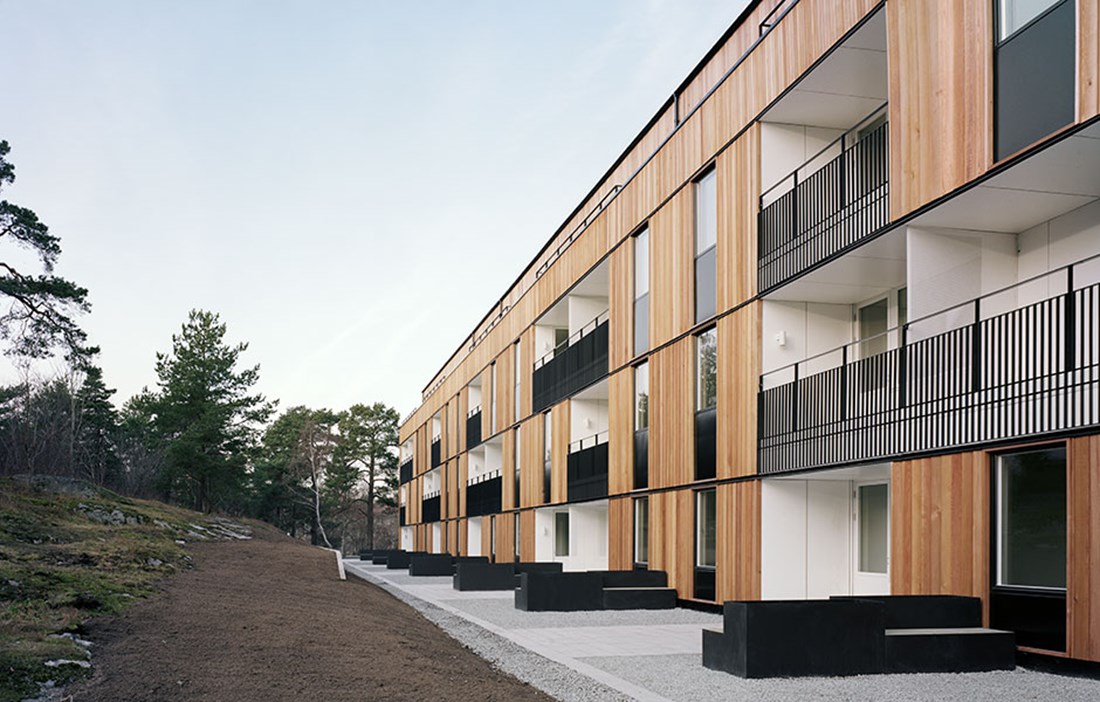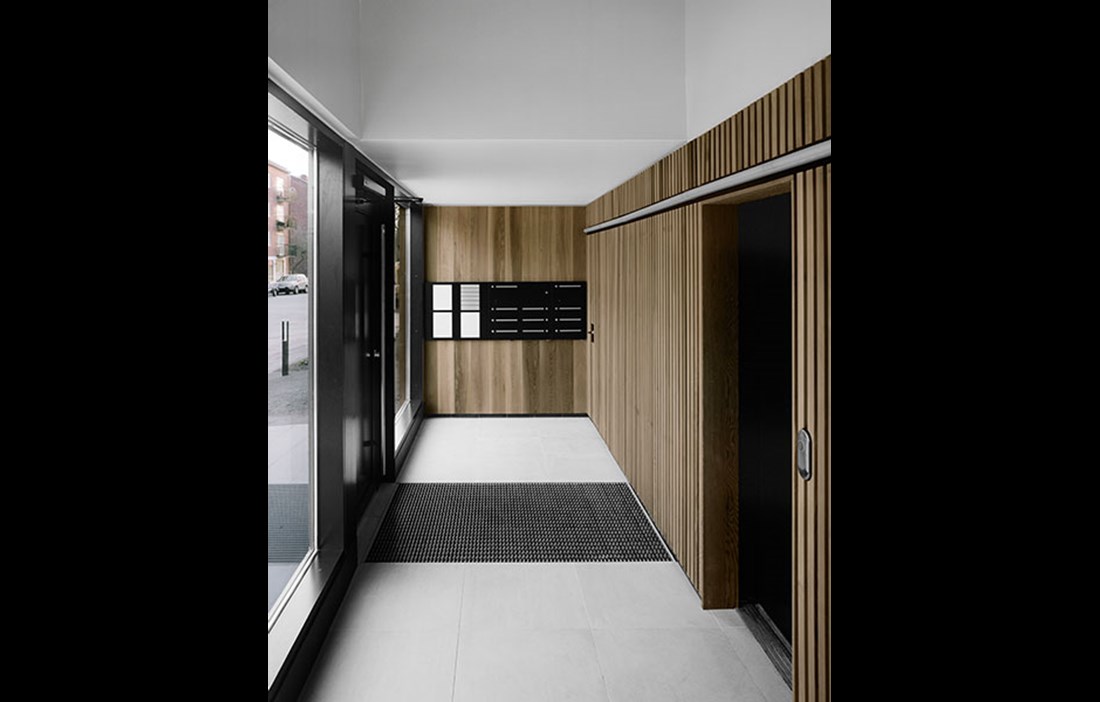IT WAS BACK in the 1930s, when the Stockholm Exhibition launched new ideas of how to solve the housing crisis, that Årsta first emerged as a pleasantly green suburb on the southern shore of Årstaviken. In 1932, Stockholm’s Real Estate Administration organised the Årsta competition, in which narrow buildings, less than 10 metres wide, would be given priority over deeper designs. One result was the long, narrow brick buildings, constructed in 1944, that now line Skagersvägen.
In 2007 the City of Stockholm launched a new competition in Årsta, this time for the development of a plot comprising rock and brushwood. The winner was Åke Sundvall Projekt. Together with Björn Ahrenby of OWC Arkitekter, they drew inspiration from those long, narrow blocks of the 1940s when designing Skagershuset.
In the dialogue between architect, developer and suppliers, there has been a clear vision and explicit requirements concerning material choice. The result is that Skagershuset both fits in and stands out – a contrast that most people enjoy.
“Beautiful! Uplifting and different, and yet somehow it still blends in. It’s cool to see them thinking differently,” says Pelle Wittheden, who has lived locally for many years.
THE BUILDING STRETCHES 80 metres along Skagersvägen, a stone’s throw from Gullmarsplan, and sits on a green and rocky slope. The building dominates the streetscape, while also blending in well with the other blocks in the area.
“That’s largely down to the creativity and skill of Björn Ahrenby, who has managed to produce something so exciting by relatively simple means. He left no detail to chance and was often personally on site to ensure the high level of precision and quality that defines Skagershuset,” says Johan Lins, CEO of Åke Sundvall Projekt.
The facade is Western red cedar, whose untreated, pure wood finish brings the long building to life and is a prime example of the attention to detail that has gone into Skagershuset. Björn Ahrenby uses three different sizes of finely sawn and planed cladding. To achieve the unbroken vertical lines that run from floor to floor, he designed the cladding on floors 1, 2 and 3 piece by piece. The cladding has been rotated to make it vertical. It is arranged in opposite directions across different panels to create a more varied and exciting facade, but it took a great deal of time and thought to achieve this precision that is such a feature of the building.
“We’re used to seeing wooden facades on detached homes and summer cottages. To ensure that Skagershuset represented quality and innovation, rather than looking like an overgrown private house, we were careful to tailor the cladding and facade details to the scale of the building,” states Björn Ahrenby.
Getting the City to accept a wooden facade took a long time and a great deal of persuasion, but now everyone involved is glad that they persevered.
“There is an honesty in using a facade in wood to show that this is a wooden building through and through. The facade will retain its warm tone as it gradually silvers due to weather exposure. It’s only treated with flame proofing to meet facade fire test method SP Fire 105 for this wood, but that doesn’t affect its appearance,” says Björn Ahrenby.
THE BUILDING HAS a simple aesthetic with a focus on vertical and horizontal lines, accentuated by the cladding, windows and lengths of flashing that protect the endgrain wood. As well as varying the facade, the apartments are sunk back above the entrances on the street, in order to break up the 80 metre long building. At the rear, the sunken niches form south-facing terraces, balconies and patios fitted with specially designed seating and balustrades. To channel as much light as possible into the apartments, the niches are clad in sheets of white Trespa Meteon, a composite material made from hard plastic and wood.
“We spent a great deal of time getting the details right. We even built a full-scale wall section with window to study how everything married up and to see how the different materials worked together. It was a huge help and led to numerous great solutions,” explains Björn Ahrenby.
He points out how the timber frame around the windows does not meet the metal on the bottom edge so rainwater can run down the window and metal, under the timber frame and out over the flashing. Fresh air is also drawn into the apartments from behind each window surround, thus avoiding visible air vents in the facade.
Skagershuset is constructed from 112 box units built around a spruce frame. The modules were prefabricated by Moelven and delivered complete with ceilings, floors, walls and kitchen and bathroom fittings, plus water, electricity, ventilation and waste. The modules were then all connected to the service shafts on site.
“Industrial construction in wood involves the use of timber, with much of the construction work taking place in a protected environment on the factory floor. It is faster, less weather dependent and provides better control over costs. The modules can also be delivered with a finished facade, but the architect behind Skagershuset wanted it installed on site to make sure the lines were right and the cladding concealed the double beams between the two box units,” says David Öberg, Marketing Manager at Moelven ByggModul.
“Whoever the supplier is, industrial construction in wood has a few limitations that must be taken into account,” adds CEO Johan Lins, stressing how important it is for architects to be aware of them.
For example, the modules have to be of a size that can be transported by lorry and that will fit on roads and under bridges. The modules also have thicker structural beams than normal, which can be a challenge if the building height is restricted. In addition, the system means committing early on in the project, with very little scope for making changes later. The advantages are, however, compelling, with Johan Lins citing less time on the building site, less transport, less disruption for neighbours, good cost control and no drying time compared with in situ concrete as clear positives about industrial construction in wood.
Åke Sundvall Byggnads had already built two other apartment blocks using Moelven’s modular system, so they were well aware of how the system worked when they decided to use it for Skagershuset. By applying creativity and innovation, and consciously keeping to Moelven’s standard materials, the developer and suppliers, together with Björn Ahrenby, achieved an efficient process that brought benefits in terms of time, economics, quality and design.
“Åke Sundvall’s previous experience of working with modular systems was a huge help, since it is difficult to design traditionally, and then try to translate it into an industrial context. It’s easier to adapt the building’s construction and organisation to the limits of the system from the beginning,” says Björn Ahrenby.
By the time the building was ready to move into, in December 2013, all the apartments were sold. With its large and light two, three, four and five room apartments, Skagershuset has broadened the housing stock in Årsta, where previously all that was on offer were small apartments in 1940s blocks.
Text Maria Ayre























